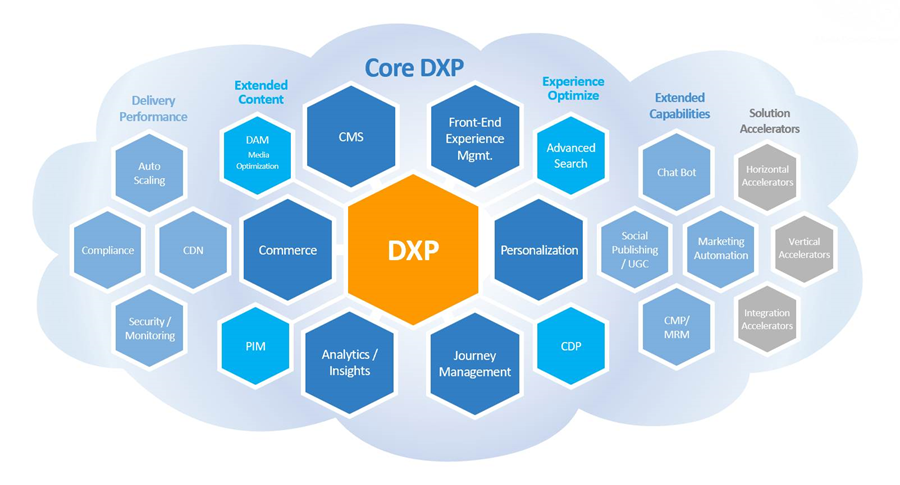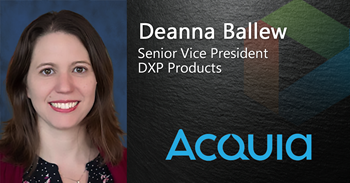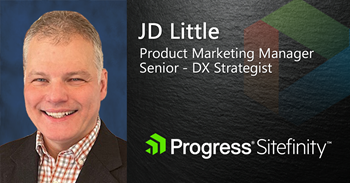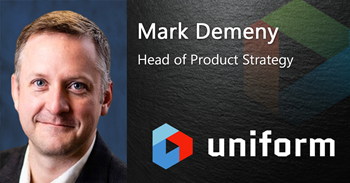The Rise of Composable DXP
By John Austin and John Austin
July 13, 2022
Acquia, CDP, CMS, Composable, DAM, DXP, MACH, Magnolia, Optimizely, Progress, Sitefinity, Uniform, WCM.
In its latest Magic Quadrant for DXP report, Gartner has placed a strong emphasis on the composable capabilities of DXP vendors. In fact, all of the vendors in the Leaders quadrant have adopted a composable suite approach that includes web content management (WCM), customer data platform (CDP), data asset management (DAM), personalization, journey orchestration, analytics, and commerce components.
 Click here to receive your free copy of the Gartner® Magic Quadrant™ for Digital Experience Platforms 2022
Click here to receive your free copy of the Gartner® Magic Quadrant™ for Digital Experience Platforms 2022
|
Gartner’s 2022 Magic Quadrant for Digital Experience Platforms
|
|
Leaders
|
Challengers
|
Niche Players
|
Visionaries
|
|
Adobe
|
Salesforce
|
Crownpeak
|
Bloomreach
|
|
Acquia
|
Oracle
|
CoreMedia
|
Magnolia
|
|
Optimizely
|
HCL Software
|
Progress Sitefinity
|
|
|
Sitecore
|
Open Text
|
Kentico
|
|
|
|
Liferay
|
Squiz
|
|
|
Gartner’s 2021 Magic Quadrant for Digital Experience Platforms
|
|
Leaders
|
Challengers
|
Niche Players
|
Visionaries
|
|
Adobe
|
Salesforce
|
Crownpeak
|
Bloomreach
|
|
Acquia
|
Oracle
|
Magnolia
|
|
|
Optimizely
|
Open Text
|
CoreMedia
|
|
|
Sitecore
|
HCL Software
|
e-Spirit*
|
|
|
Liferay
|
|
Squiz
|
|
* e-Spirit was acquired by Crownpeak
|
Gartner’s 2020 Magic Quadrant for Digital Experience Platforms
|
|
Leaders
|
Challengers
|
Niche Players
|
Visionaries
|
|
Adobe
|
Salesforce
|
Crownpeak
|
Bloomreach
|
|
Sitecore
|
Oracle
|
CoreMedia
|
|
|
Acquia
|
Open Text
|
Kentico
|
|
|
Liferay
|
SAP
|
Squiz
|
|
|
Episerver*
|
|
|
|
* Episerver is now Optimizely
|
Gartner’s 2019 Magic Quadrant for Digital Experience Platforms
|
|
Leaders
|
Challengers
|
Niche Players
|
Visionaries
|
|
Adobe
|
Oracle
|
CoreMedia
|
Episerver*
|
|
Sitecore
|
Microsoft
|
SDL
|
Bloomreach
|
|
IBM
|
SAP
|
Crownpeak
|
|
|
Salesforce
|
Open Text
|
Kentico
|
|
|
Liferay
|
Acquia
|
Squiz
|
|
* Episerver is now Optimizely
|
Gartner’s 2018 Magic Quadrant for Digital Experience Platforms
|
|
Leaders
|
Challengers
|
Niche Players
|
Visionaries
|
|
Adobe
|
Microsoft
|
CoreMedia
|
Episerver*
|
|
IBM
|
Salesforce
|
Crownpeak
|
Bloomreach
|
|
Sitecore
|
Oracle
|
SDL
|
|
|
Liferay
|
Acquia
|
Jahia
|
|
|
|
SAP
|
Kentico
|
|
|
|
Open Text
|
Squiz
|
|
|
|
|
Censhare
|
|
|
|
|
Oxcyon
|
|
|
|
|
GX Software
|
|
* Episerver is now Optimizely
Driven by demand for more agile, nimble, and future-proof systems, digital experience (DX) software applications have transformed over the last decade, giving rise to composable DXP solutions. The transition began with federated content experience delivery, a way to efficiently manage information by accessing and assembling content that resides in separate sources, served to digital experiences built on different platforms. Federated capabilities then evolved into headless CMS solutions, which took an API-first approach to experience delivery and enabled the implementation of more advanced digital experiences. Headless offerings from vendors have continued to improve to accommodate ever-more comprehensive, composable experience delivery capabilities.

It is also worth noting that Gartner does not include headless CMS vendors that lack core DXP capabilities within their product offerings, such as Contentful, Contentstack, and Kentico Kontent. These vendors have focused on elevating their core content management capabilities by integrating third-party complementary technology solutions like CDP, DAM, and digital commerce offerings to provide more advanced DXP capabilities.
Evaluating Composable DXP Vendors
When evaluating the strengths of composable DXP vendors, it is critical to look beyond the basic capabilities of their software to assess how they fully support composable DX solutions. CMS-Connected reached out to a cross-section of the DXP vendors included in the Gartner Magic Quadrant to better understand their composable DXP strengths. Our questions focused on the following:
- Ecosystem Integrations: The scope, strength, and quality of the vendor’s integrations capabilities into third-party solutions.
- Solution Accelerators: The vendor’s level of commitment to enabling and encouraging the development of third-party low-code no-code solutions accelerators.
- Strategic Ecosystem Partnerships: The vendor’s strategic technology partnerships and how these partnerships drive innovation and advancement of the vendor’s solution offerings.
- Composable Solution Strengths of Partner Ecosystem: The strengths of the vendor’s solution partner ecosystem and its ability to support and deliver end-to-end multi-vendor composable solutions.
- Vendor’s Vision for the Future of Composable: To understand the vendor’s vision for the future of composable and how their product roadmap strategy aligns with this vision.
Click on any of the four vendor logos to read the full interviews:
Optimizely
Interviewee: Kara Anderson, Senior Product Marketing Manager 
Integrations and solution accelerators are vital components of Composable DX solutions. We want to understand better how Optimizely supports third-party integrations and solutions accelerators.
Integration Challenges
One of the biggest challenges DXP vendors face when trying to support the integration needs of their customers is the sheer number of potential Martech applications to integrate. Can you talk about Optimizely’s approach to addressing this challenge?
"We pay close attention to our customers’ needs and the problems they’re trying to solve to understand how to focus our integration efforts. In particular, we’ve identified different needs among marketers—who want plug-and-play integrations they can set up quickly on their own, and developers—who look for flexibility and control. So we offer low or no code integrations through our marketplace that non-technical marketers and business users can set up in a few clicks. While developers can leverage the highly flexible integration points that are built natively into core Optimizely products."
Strategic Technology Partnerships
Can you talk about any strategic technology partnerships that Optimizely has developed to advance your innovation and support for composable solutions? Do you have pre-built integrations with these vendors, or have you developed any joint solutions?
"We have developed several pre-built integrations with strategic technology partners that can be found in our marketplace. Most recently, we’re excited about our partnership with Google Cloud to advance our innovation in experimentation. Through the partnership, customers can benefit from working with the de facto leader in experimentation for enterprise companies and Google Cloud’s trusted, secure infrastructure and capabilities in AI, ML, and analytics. We will continue to collaborate closely with Google Cloud on co-innovation, developing new and expanded digital offerings that bring the best experience possible to our customers."
Extended Ecosystem
Can you talk about the role your partner ecosystem (technology and implementation partners) plays in building solution accelerators and pre-built low code integrations into third-party DX-related applications?
"Our trusted technology and solution partners have been collaborating with us for years on integrations for our marketplace and on custom integrations for customers. Contributions from our partners will continue to be vitally important as the need to integrate and deliver experiences with composable applications grows."
Partner Enablement of Solution Accelerators
How does Optimizely motivate and support your ecosystem partners to build solution accelerators? Do you have a joint innovation program in place?
We collaborate with our partner ecosystem to leverage our respective expertise in digital business applications. Our joint innovation is targeted in areas where partners can accelerate our offerings to customers in emerging areas of digital experience.
Vertical Solution Accelerators
What is your strategic view of vertical solution accelerators? Do you see vertical solution accelerators becoming a staple of your DXP strategy?
"Our DXP currently offers vertical-specific integrations and solution accelerators, and this will continue to be part of our strategy. Line of business applications in B2B Commerce, such as pre-built integrations for ERP and order automation, are popular examples in our marketplace."
Integrations with Competing Solutions
One of the primary concepts of composable is freedom and flexibility when it comes to the technologies employed in building and extending a DXP stack. As a DXP suite vendor, can you talk about how Optimizely balances being a suite vendor and supporting third-party integrations with competing solutions?
"We currently develop several integrations in our marketplace with what may be considered competing solutions. Ultimately the goal is to give our customers the freedom, flexibility, and functionality they need to provide the best digital experiences for their customers, and any part of our application is designed to integrate in order to achieve that goal."
Composable UI: Does Optimizely have a UI for developing Headless front-ends?
Yes, our standard UI enables the development of headless front-ends.
Marketplace
Optimizely has a Marketplace. Can you talk about the role of your marketplace in supporting your composable DXP strategy?
'The Optimizely App Marketplace offers a variety of additional applications, integrations, and connectors that enable our customers to compose custom solutions that broaden the digital experience.
'Customers can find third-party marketing technology connectors that exchange data between Optimizely and third-party systems, presentation layer apps that add JavaScript or tags to the HTML presentation layer of Optimizely Content Cloud and Commerce websites, and embedded applications that add new capabilities to the Optimizely editor UI."
Qualify Control of Third-Party Solution Accelerators
Another significant challenge vendors face is ensuring the quality of integrations and solution accelerators available in their marketplace. Can you talk about Optimizely’s approach to ensuring the integrity and quality of third-party solution accelerators found in your marketplace?
"All of the applications in our marketplace are rigorously tested and certified by our engineering teams. They are continuously integrated into releases for compatibility. We support our customers and their solutions that include these accelerators, in addition to the custom integration work they may have delivered."
Other Integration Strengths
Are there any additional integration strengths of Optimizely related to delivering composable DX solutions that you think should be highlighted?
"All products in the Optimizely suite have been designed from the API outwards, so customers have the flexibility to use, or not use, our UI. We’ve been careful to allow control of our tools from other systems and to enable customers to use our platform as an aggregation point for their entire suite of DXP tooling."
Clarification — Product Versatility
In their evaluation of Optimizely, Gartner talks about a lack of versatility compared to some of the other DXP vendors, as well as the potential for your recent acquisitions to disrupt your product roadmap. Can you share your perspective on these assessments and provide more clarity on your vision for how your recent acquisitions fit into your overall DXP product roadmap?
"We’ve taken an aggressive approach to our product roadmap, integrating many of our capabilities in customer data, personalization, recommendations, experimentation, and commerce to strengthen our core product areas and provide consistency and flexibility across our DXP.
"With the recent addition of Welcome software to our DXP, our vision is to revolutionize the way teams produce and publish content. Where content creation once happened across various disjointed draft documents, meetings, and other communication tools, now all stages of the content lifecycle — from ideation to optimization — will take place in the DXP, accelerating team alignment and collaboration so they can go to market faster."
Future of DXP
Looking ahead, what does Optimizely see as the next big trend in the DXP space that will shape the evolution of DXP solutions? What can you share regarding your product strategy roadmap that aligns with these trends?
"Two areas that will continue to emerge and converge are emerging media and AI. As new, immersive experiences are developed, we will be at the forefront by not only supporting these modes but encouraging teams to experiment with them. AI will continue to surface opportunities for customer service based on increasing sets of behavior and outcomes and will help experience teams automate these interactions for customers and self-service."
Acquia
Interviewee: Deanna Ballew, Senior Vice-President DXP Products 
Integrations and solution accelerators are vital components of Composable DX solutions. We want to understand better how Acquia supports third-party integrations and solutions accelerators.
Integration Challenges
One of the biggest challenges DXP vendors face when trying to support the integration needs of their customers is the sheer number of potential Martech applications to integrate. Can you talk about Acquia’s approach to addressing this challenge?
"Acquia takes an API-first approach to integration. We prize openness, and we enable our customers to use the martech tools of their choice because many of those tools solve niche problems really well. So rather than pushing them to products we build or select, we want to enable a best-of-breed approach. In this way, with Acquia DXP, data and business logic are integrated across tools."
Strategic Technology Partnerships
Can you talk about any strategic technology partnerships Acquia has developed to advance its innovation and support for composable solutions? This is an area Gartner felt Acquia was lacking. Do you have pre-built integrations with these vendors, or have you developed any joint solutions?
"We offer a reference architecture that provides common experience and data layers. This allows Acquia to work with partners to create composable, pre-packaged services that enable better time to value for our joint customers. The type of application doesn’t matter — partners can build out any number of applications within the framework of our DXP."
Extended Ecosystem
Can you talk about the role your partner ecosystem (technology and implementation partners) plays in building solution accelerators and pre-built low code integrations into third-party DX-related applications? What advantages do you feel Acquia has as an open source solution with the development of third-party integrations?
"Acquia is committed to supporting our global channel and technology partner ecosystems. For us, that starts with a strong commitment to Drupal itself, the open source content management system at the heart of our DXP. We’re the largest corporate contributor to Drupal and believe the project’s more than 45,000 modules are a substantial differentiator when it comes to extending the power of customer experience applications.
"Products like Acquia Code Studio and Acquia CMS harness these modules and then layer in application services to empower technologists and content creators. They can plug and play from an ecosystem of third-party services from the MACH Alliance vendors, for example, quickly and easily."
Partner Enablement of Solution Accelerators
How does Acquia motivate and support its ecosystem partners as well as the Drupal community to build solution accelerators. Do you have a joint innovation program in place?
"In late 2021 we introduced the Acquia Practice Certification (APC) program, which awards credentials to partner organizations who meet the highest standards of technical delivery on the Acquia platform. The program creates a framework for rewarding partners who deliver the highest quality business engagements. It also provides a roadmap for partners who are trying to achieve that level of excellence. Partners achieving certification receive a variety of rewards and recognition, including deeper coordination with Acquia teams for solutions implementation and delivery."
Vertical Solution Accelerators
Acquia developed a solution accelerator for the UK Government. Do you see vertical solution accelerators as becoming a staple of your DXP strategy in the future?
"Acquia DXP is a horizontal platform built to support all verticals and customer use cases. When evaluating our product requirements across verticals, we think about the end user first. Many industries face similar macro challenges that diverge at the organizational level but then impact end users in the same way. The end user is looking for an intuitive, personalized, easy-to-navigate solution when it comes to digital experiences. Our customers, regardless of industry, need to provide this in an efficient and flexible way.
"As we build out capabilities to support customer use cases, we leverage our partner community for vertical-specific expertise. This may come in the form of industry-specific insights, integrations, or extensions. We also work with channel partners to pre-compose end-to-end solutions tied to specific use cases, as well as third-party integrations as part of our composable enterprise strategy."
Integrations with Competing Solutions
One of the primary concepts of composable is freedom and flexibility when it comes to the technologies employed in building and extending a DXP stack. As a DXP suite vendor, can you talk about how Acquia balances being a suite vendor and supporting third-party integrations with competing solutions?
"Customers own their data and their digital experience stack. The Acquia platform is the engine of the DX stack, and because we’ve built it using open technologies and APIs, our customers have the freedom to keep on using products and technologies that are already embedded in their organization. The integrations we focus on allow our customers to realize the value in the solutions they purchase us from us as quickly as possible.
"Acquia doesn’t believe that trying to lock our customers into using only our technology is good for them — we prefer to build integrations, including competitive products, and allow customers to decide for themselves what they want their DX stack to look like."
Composable UI
Does Acquia have a UI for developing Headless Front Ends?
"Acquia provides a packaged Headless CMS that offers preview capabilities for the decoupled front end. It also offers a unique process for adding decoupled components to the CMS, which can be assembled using low code tools. While this approach does not create a fully decoupled front end, there are solutions available from the Drupal community that do."
Marketplace
Can you talk about the role of Drupal’s marketplace in supporting your composable DXP strategy? Do you feel the Drupal Marketplace fully supports your marketplace needs, or has Acquia considered developing a marketplace that supports your entire product suite?
"We aim to make it easy for our customers to build out their digital experience stack. Integrations and expanded capabilities are critical in many areas. Our current focus is on integrations with Acquia DAM and Acquia CDP and extending integrations further with partners like Workato."
Qualify Control of Third-Party Solution Accelerators
How do you ensure the integrity and quality of third-party integration solution accelerators developed in the Drupal Marketplace?
"The Drupal community has an optional security review process for approving any modules in the marketplace. Modules that have security coverage are clearly marked and are included in security advisory updates. This process allows community contributions to continue unimpeded to facilitate the free flow of open source code while making it very clear which modules have formal coverage and which ones may need additional scrutiny."
Other Integration Strengths
Gartner identified Acquia’s strength in composable modular DX solutions. With that said, are there any additional integration strengths related to Acquia delivering composable DX solutions that should be highlighted?
"As noted, one of our greatest strengths comes from our open-source heritage. The idea that customers should never be locked in effects everything we do and means we’ve been taking a composable, modular approach from our beginning as a company. Our commitment includes an open architecture, of course, that allows customers to rapidly create, share, and reuse lightweight application modules to deliver new digital experiences.
"It also means open content modeling and open experience modeling to define core design systems, components, and reusable elements to support rapid composition experiences and journeys. Beyond that, it encompasses open integrations to ingest customer data from internal and external systems. An open data model allows rapid de-duping, cleansing, and more to resolve customer identities across channels, devices, and touchpoints into a single view of the customer. Open ML modeling enables analysts to build and reuse custom models to leverage unique data sources to identify next-best content, next-best channel, next-best action, and next-best experience."
Clarification — Product Versatility
In their evaluation, Gartner felt Acquia had a slower innovation pace than other leading DXP vendors. Can you give us your perspective on this?
"Much of Acquia’s focus is on innovations around scalability and security to ensure our customers can meet the demands of their own customers."
Future of DXP
Looking ahead, what does Acquia see as the next big trend in the DXP space that will shape the evolution of DXP solutions? What can you share regarding your product strategy roadmap that aligns with these trends?
"Forward-thinking organizations are looking to re-invent their digital stacks in a way that puts their own customers at the center. To do this, they often want to consolidate disparate investments in multiple CMSes, DAMs, commerce systems, and more into one open, microservices-based, cloud-native digital architecture. Within that framework, they’re looking for a single, consolidated set of core services for managing code and content, customer data and insights, journey orchestration, experience delivery, and customer lifecycle optimization. We believe a DXP that is open at its core fits the needs of IT teams while empowering marketers. By empowering marketing with the low-code or no-code tools, they need to design, assemble, and deliver new experiences and build digital-first businesses."
Magnolia
Interviewee: Salvador Lopez Jr., Director of Marketing, Americas 
Integrations and solution accelerators are vital components of Composable DX solutions. We want to understand better how Magnolia supports third-party integrations and solutions accelerators.
Integration Challenges
One of the biggest challenges DXP vendors face when trying to support the integration needs of their customers is the sheer number of potential Martech applications to integrate. Can you talk about Magnolia’s approach to addressing this challenge?
"At Magnolia, we’ve always felt that companies should be able to use whatever solutions they deem best for them and not be boxed into any particular set of tools. Facilitating meaningful integrations has been one of our core value drivers long before the concept of composable DXP became popularized.
"We approach this by designing Magnolia to serve as the core of an organization’s digital experience platform. Magnolia becomes a central hub through which all systems are connected. Our universal connector framework takes much of the heavy lifting out of building integrations. It allows for REST integrations using YAML configuration — or what we call Light Development — so integrations can be made without needing any Java development.
"Our Integrated User Experience, or IUX, is essential to allowing Magnolia to serve as the central hub of the composable DXP. It brings elements and actions from connected applications directly into the Magnolia user interface. A simple example of this is being able to view the third-party analytics data for a page without ever having to leave Magnolia. This eliminates the need for users to hop back and forth between systems to get their work done. We’ve seen many great examples of solid end-user experiences from groups of vendors. But the business user’s workflow and user experience are often terrible as they need to keep twenty tabs open and mentally bridge data and content. The IUX concept is created to make the business user’s workflow sane – while still getting all the benefits from rich composability."
Strategic Technology Partnerships
Magnolia’s DXP is built around best-of-breed components from different vendors. Can you talk about any strategic technology partnerships that Magnolia has developed to advance your innovation and strengthen your support for composable solutions? Do you have pre-built integrations with these vendors, or have you developed any joint solutions?
"Magnolia has a number of strategic technology partnerships best illustrated through our Connector Packs. These Connector Packs provide blueprints for easy integration and off-the-shelf connectors that extend Magnolia natively into the other core technologies that make up the composable DXP. They are built on a unified framework that lets companies take advantage of common microservices across their platforms.
"We have Connector Packs dedicated to the following areas:
- Commerce: Salesforce Commerce Cloud, commercetools, Adobe Commerce Cloud, SAP
- Marketing Automation: Marketo, Salesforce Sales Cloud
- Analytics: Google Analytics, Adobe Analytics, Matomo
- Digital Asset Management: Bynder, Amazon S3
- Optimization: Siteimprove"
Extended Ecosystem
Can you talk about the role your partner ecosystem (technology and implementation partners) plays in building solution accelerators and pre-built low code integrations into third-party DX-related applications?
"The Magnolia Marketplace is the central hub for Connectors, special features, and third-party extensions of Magnolia. Our partners play a critical role in the Marketplace by providing extensions that are available to our customers. There are a variety of these third-party extensions already available in the Marketplace, including some related to personalization, content synchronization, and ecommerce.
"We look forward to our partners continuing to use their Magnolia expertise to provide extensions that improve the product for our customers."
Partner Enablement of Solution Accelerators
How does Magnolia motivate and support your ecosystem partners to build solution accelerators? Do you have a joint innovation program in place?
"We promote to our partners the benefits of adding their 3rd party extensions to the Magnolia Marketplace. It not only offers them a chance to showcase their Magnolia expertise but also the opportunity for lead generation and increased revenue.
"Contributors to the Marketplace have access to a number of resources designed to help them promote their extensions to a wider audience. This is something we actively promote as we engage partners via our newsletters, partner webinars, partner meetings, etc."
Vertical Solution Accelerators
What is your strategic view of vertical solution accelerators? Do you see vertical solution accelerators becoming a staple of your DXP strategy?
"The ability for organizations to launch and work more quickly has long been a focus of Magnolia, so any way we can get developers working faster will continue to be a focus.
Our recently released Headless Accelerator is a great example of this. It provides a library of UI patterns for front-end frameworks meant to speed up development time. Its library of high-quality components — such as shopping carts and navigation — can be used and customized to create something unique. With our unified workflow, developers are able to manage these components in the front-end framework of their choice.
"This adds to our ready-made integrations for e-commerce solutions, which I’ve mentioned previously, to make building out and managing a robust e-commerce site much easier.
In the future, you’ll see a portal solution accelerator, which should be of particular use in the verticals of fintech, energy, and utilities."
Composable UI
Does Magnolia have a UI for developing Headless front ends?
"We believe that developers are most effective and efficient when able to work in their developer tools, such as their IDE and code repository. This is why we enable them to use the UIs they are already using to work with Magnolia.
"Magnolia’s file-based configuration stems from this belief. File-based configuration allows developers to use Git to manage Magnolia configuration files. It also enables low-code development, for example, to create delivery APIs, enable GraphQL, or provide personalized content via an endpoint, serving headless frontends.
"To enable developers to build headless front ends faster, we recently introduced the Magnolia Headless Accelerator. It is a developer tool that provides a unified design system to accelerate front-end development, offering:
- A library of UI patterns for the most popular front-end frameworks
- Typesafe programming in an IDE of the developer’s choice
- Task automation via command line from their IDE"
Marketplace
Can you talk about the role of your Marketplace in supporting your composable DXP strategy?
"The Magnolia Marketplace is a platform where we and our partners offer extensions to the Magnolia DXP. The categories include typical CMS functionality such as content management, development & operations, and translation. Our other categories, such as commerce, digital asset management, analytics, and optimization & personalization, offer integrations with third-party systems, enabling the composable DXP."
Qualify Control of third-party Solution Accelerators
Another significant challenge vendors face is ensuring the quality of integrations and solution accelerators available in their Marketplace. Can you talk about Magnolia’s approach to ensuring the integrity and quality of 3rd party solution accelerators found in your marketplace?
"Each extension added to the Magnolia Marketplace must meet a well-defined set of requirements before being made publicly available.
Other Integration Strengths: Magnolia had the most significant improvement in the GMQ rankings of all the DXP vendors — improving in both the ability to execute and completeness of vision. But unlike the DXP suite vendors that dominate the Leaders Quadrant, Magnolia has taken a lean approach focusing on integration with third-party applications to build DXP solution stacks."
Other Integration Strengths
Are there any additional integration strengths of Magnolia related to delivering composable DX solutions that you think should be highlighted?
"We believe a composable DXP lays the foundation for delivering engaging omnichannel experiences, flexibly and efficiently. The core idea behind our platform is composability:
- Choose software that works best for you
- Start with your must-have building blocks
- Add or swap out building blocks to adapt to your customers’ needs
"Unlike a software suite, this approach lets our customers build a custom platform that has all — and only — the capabilities they need. And unlike a point solution, they get all the DXP integrations to bring together content, data, and services seamlessly.
"There is a reason why there are multiple vendors in the market for analytics, DAM, or marketing automation. They deliver different capabilities that serve specific-use cases better and offer enterprises choice. The competition in the market also drives innovation. Composable DXP enables enterprises to benefit from this choice and innovation to build exactly the DXP they need.
"Magnolia offers maximum integration capabilities through pre-built connectors in our Connector Packs, an open integration framework, REST APIs, GraphQL, and an API client (Multisource), enabling enterprises to connect with all systems imaginable, from modern API-first cloud platforms to Y2K legacy systems, if need be."
Clarification — Product Versatility
In their evaluation of Magnolia, Gartner talks about Magnolia’s lack of market awareness in North America. Can you give us your perspective on this and also talk about the strength of your partner ecosystem in North America?
"It is a fair assessment to say, relatively speaking, that we don’t have the same level of market awareness as some of our competitors who have been entrenched in this market longer.
However, we do have an ever-expanding footprint in North America consisting of some of the region’s leading names in their industries, such as The New York Times, JetBlue, Jabil, VSP, and too many others to list.
"We are proud that our growth within North America – and even globally – has been completely organic and not done through acquisitions. Our steady growth here is largely a reflection of the quality of our software and its ability to fit into how modern organizations prefer to build digital experiences. Our presence in North America should continue to grow with each passing year.
"Our regional partners are a big part of this, of course. We have a well-rounded base of partners in North America. Partners we work with come in a range of sizes, have a variety of vertical and technological expertise, and cover all geographic regions. This means that any organization looking to implement Magnolia through a system integrator can be confident they’ll find a partner that fits their unique needs."
Future of DXP
Looking ahead, what does Magnolia see as the next big trend in the DXP space that will shape the evolution of DXP solutions? What can you share regarding your product strategy roadmap that aligns with these trends?
"We’ve covered it quite a bit here, but we truly believe that the composable DXP is where the space is heading. There’s simply a level of flexibility and agility that can’t be matched by suite options. So, look for more and more focus on integrations and modularity as the DXP market becomes more mature."
Progress Sitefinity
Interviewee: J.D. Little, Product Marketing Manager, Senior DX Strategist 
Integrations and solution accelerators are vital components of Composable DX solutions. We want to get a better understanding of how Progress Sitefinity supports third-party integrations and solutions accelerators.
Integration Challenges
One of the biggest challenges DXP vendors face when trying to support the integration needs of their customers is the sheer number of potential Martech applications to integrate. Can you talk about Progress Sitefinity's approach to addressing this challenge?
"With Sitefinity DX, integration is approached in several different ways, offering both flexibility and ease of use for customers seeking composability in their Martech stack. We support connectivity to other Progress tools, such as NativeChat and Sitefinity Insight, as well as plugins and connectors to the tools of our technology partners. Of course, Sitefinity has always facilitated code-based API integrations, and many of our customer stories focus on the creative use of that option. Recent Sitefinity releases have included enhanced low-code capabilities with Sitefinity Service Hooks, as well as a fully decoupled front end based on a new .NET Core framework. Together, these offer a range of opportunities for extensibility and integration for seamlessly connecting key business and marketing systems across any enterprise."
Strategic Technology Partnerships
Gartner talks about Sitefinity not having a very extensive product portfolio or third-party integrations required to provide a complete DXP offering. Can you provide your perspective on this and discuss any strategic technology partnerships that Sitefinity has developed to provide a complete DXP offering and support composable solutions? Do you have pre-built integrations with these vendors, or have you developed any joint innovations?
"The guidance we've received from Gartner analysts over the past few years has been instrumental in the formation of our vision and roadmap. We are grateful for this guidance, and our business plan has benefited in innumerable ways from their advice. With Sitefinity DX, we are accelerating the inclusion of more of our own products into the story by connecting Sitefinity to our own Secure File Transfer, Chatbot, and Decision Automation offerings. From our perspective, this is just a fresh way of presenting Progress as the trusted, full-service developer of platform software our customers have relied upon for 40+ years. It is also timely and compelling, as the composability of these tools aligns with trends of our industry as the analysts have recorded."
Extended Ecosystem
Can you talk about the role your partner ecosystem (technology and implementation partners) plays in building solution accelerators and pre-built low code integrations into third-party DX-related applications?
"Our partner ecosystem is strong and growing. Solution accelerators include plugins for commerce, extended DAM capabilities, and partner integrations for specialized portals. We are expanding platform connectivity options with out-of-the-box connectors for DAM systems, personalization options for ecommerce, and pushing forward new applications for our low code integration service. In the spirit of delivering composable capabilities, we have expended significant effort to support broader DX scenarios for enterprises, with other Progress products augmenting Sitefinity in areas of rapid UI and mobile development, digital decisioning, data connectors, and secure file transfer. Our partners, of course, will be essential to the success of all these initiatives."
Partner Enablement of Solution Accelerators
How does Sitefinity motivate and support your ecosystem partners to build solution accelerators. Do you have a joint innovation program in place?
"We employ Partner Account Managers who are available for questions, support, communication, and motivation. This is above and beyond the partner enablement and training we provide on an ongoing basis. With each new release (major and minor), messaging documentation and webinars are provided. We elevate individuals who show a special passion for our DX solution with other Progress tools as we invite them to participate in our MVP program. Our MVPs are engaged community advocates who promote Progress and creatively present our products. These MVPs, selected from our partner channel, are emissaries for Progress in both the worldwide and local communities."
Vertical Solution Accelerators
What is your strategic view of vertical solution accelerators? Do you see vertical solution accelerators becoming a staple of your DXP strategy?
"Some of our best partners have created accelerators for specific use cases such as banking websites and commerce platform integrations. These take advantage of the literally hundreds of Sitefinity widgets at their disposal. Generally, these are specific to the vertical markets our partners serve and are partner-driven initiatives. As a product strategy, we strive to make our platform flexible, easy to use, and composable, in no small part, to support this creative development."
Composable UI
Sitefinity has a UI for developing Headless front ends. Can you provide some insights into this solution? Does it support third-party integrated components directly within the UI when building composable experiences?
"Yes, to all. With Sitefinity DX 14, we enhanced headless content and presentation capabilities for experience management at scale. Our headless API includes layout and personalization metadata, as well as advanced caching for optimal end-user performance, extending experience management to any presentation channel that supports a page/widget model. With Sitefinity DX 14, we added a low-code integration layer to enable rapid MarTech system integration, including options to use predefined and custom events in Sitefinity to trigger actions in middleware and other systems. Tightly connected ecosystems of key Marketing Automation services and data solutions are built easily and seamlessly with Sitefinity. With our low-code option, even experienced developers are empowered to iterate faster and innovate more."
Marketplace
Can you talk about the role of your marketplace in supporting your composable DXP strategy?
"The Sitefinity Marketplace is a collaborative resource for users that allows our community to easily share and download solutions that extend the Sitefinity digital experience for enhancements such as DAM integration, search options, commerce connectivity, and other uses. Since these offer options for connectivity to multiple products in each of these categories, they are effective toward providing our customers with the extensibility and composability they require."
Qualify Control of Third-Party Solution Accelerators
Another prominent challenge vendors face is ensuring the quality of integrations and solution accelerators available in their marketplace. Can you talk about Sitefinity's approach to ensuring the integrity and quality of third-party solution accelerators found in your marketplace?
"We have fantastic partners, and everything in our marketplace is created by these partners and trusted developers. All submissions are vetted and approved before they are made publicly available. This is true of all plugins, apps, and accelerators that our customers might access there. This process is designed to ensure the integrity and quality of each submission. Visitors to our marketplace page will also see that we highlight and feature the very best solutions our community develops."
Other Integration Strengths
This is the first-time Progress has been included in the Gartner MQ for DXP. Can you talk about your product strategy and the investments you made to advance your DXP offering, which led to the MQ? Are there any additional integration strengths of Sitefinity related to delivering composable DX solutions that you think should be highlighted?
"Although Progress is new to the Gartner Magic Quadrant for DXP, this is not the first time Progress has appeared in an analyst report for Sitefinity, nor is it our first time in a Magic Quadrant.
"In seeking admission to the Magic Quadrant for DXP, we first sought advice from Gartner and other analysts over several years. As stated before, this helped us put our plan on paper. After that, with heads down and sleeves rolled up, our product team worked tirelessly to innovate, rethink, and ultimately transform a solid content management offering (with some digital experience capabilities) into a formidable digital experience platform with a future-focused vision, massive integration options, and strong partner alliances.
"Simultaneously, we took a deep look into our other time-tested product offerings to find ways to leverage the strengths we already possessed. Gartner's criteria for inclusion include targets for revenue, regional reach, extensibility, and cloud deployment capabilities. It became abundantly clear to us that our long history as a creator of platforms used by other developers was a strength few of our competitors could replicate. This is an evolving process, but we foresee great opportunities for Progress and the (literally) hundreds of thousands of enterprises running their mission-critical business systems on Progress software."
The Road Ahead for Composable
All indications are that composable solutions represent the future of digital experience platforms. Over a relatively short period of time, we have witnessed DXP vendors make significant advancements in their capabilities to support composable solutions, yet, there remains considerable room for improvement. This is particularly true concerning the support for composable DX solutions built using components from multiple vendors. While vendor ecosystem synergy is critical for the adoption, growth, and overall success of composable solutions, the reality is that the majority of DX software vendors continue to struggle to play nice in the sandbox.
When it comes to improving vendor support for composable solutions, the four areas we believe vendors should focus their efforts include:
Industry Standards
Currently, there is a distinct lack of industry standards in the DXP space. From a technology perspective, MACH architecture has emerged as the primary accepted st andard for DXP vendors. The MACH Alliance (an industry association) continues to work on creating better synergy between DX ecosystem vendors by advocating for open and best-of-breed enterprise technology structures.
andard for DXP vendors. The MACH Alliance (an industry association) continues to work on creating better synergy between DX ecosystem vendors by advocating for open and best-of-breed enterprise technology structures.
Two significant friction points that the MACH Alliance could help address would be:
- Advocating for more uniform standards around vendor pricing models. Customers often struggle to determine and forecast consumption or subscription costs when evaluating multi-vendor DXP solution stacks.
- Establishing processes and standards for providing multi-vendor support of DX solutions, which can otherwise prove very inefficient and frustrating for customers. Vendors must foster tighter relationships between ecosystem partners and develop more integrated multi-tier support models and systems with these ecosystem partners.
Incidentally, none of the DXP vendors currently featured in the Gartner Magic Quadrant are members of the MACH Alliance.
Truly Unifying Multi-Vendor DXP Stacks
While traditional DXP and composable suite DXP solutions have provided very powerful user interfaces, the same cannot be said for multi-vendor composable solutions. Building a unifying user interface that integrates with solutions from competitors has not been readily adopted by DXP vendors, particularly DXP suite vendors. This has resulted in a step backward in empowering those tasked with creating, managing, and administrating digital experiences.
One emerging solution to this problem, which also offers vendor neutrality, comes from Uniform — a startup recently included in Gartner’s “Cool Vendor” report. Uniform is working to address the integration challenges of multi-vendor composable solutions, which include providing a unifying experience management interface. We reached out to Mark Demeny, Head of Product Strategy at Uniform, to get his perspective on the road ahead for composable DX solutions.
“Headless approaches have brought major benefits to their users: faster time to value and better performance via cloud-delivered SaaS, choice of front-end approaches, and better connectivity with other systems and channels via API-first delivery. However, business teams such as merchandisers and marketers have often been left behind as decoupled approaches often mean disconnected processes and interfaces.
"The next major evolution in this space will focus on creator experience to make it easier for practitioners to understand and orchestrate building experiences using data and content from multiple sources seamlessly. This evolution in the market will bring many more visual and no-code tools for building experiences, customer journeys, and content relationships in a way that allows for rapid experimentation and testing while still giving underlying vendor flexibility.”
Solution Accelerators
To effectively bring the speed, flexibility, and agility promised by composable solutions would be to encourage the development and commercialization of low-code/no-code vertical and horizontal accelerators.
A good starting point for vendors would be to invest more in their marketplaces, as overall, DX vendor marketplace strategies have not been well executed. Much can be learned from Salesforce and its success with the Salesforce AppExchange.
Automation
While in many areas, DXP capabilities are becoming commoditized, innovative use of AI and machine learning can provide vendors with an opportunity to differentiate themselves. DXP vendors are still in the early stages of utilizing machine learning and AI, which have focused mainly on recommendation engines, predictive targeting, and auto-tagging content to improve search experiences, user accessibility, SEO, and support automated personalization.
In the future, AI and machine learning could play a more substantial role in content creation and automation of the management, delivery, and optimization of digital experiences at scale. One area that could prove interesting with composable solutions would be the implementation of something I call "smart components". Smart components would utilize AI to automate the next level, configuration of application-level low code/no code components, and provide the ability to create sophisticated digital experiences — even when deployed by non-technical users.
Final Thoughts
Building ecosystem synergy is no easy feat. Vendors need to rethink and broaden their strategic technology partnerships and solution partner channels to better align and support multi-vendor composable solutions.
Organizations that will be successful in leading the next generation of DXP vendors are those that will:
- champion an open ecosystem approach to composable DX solutions
- support and apply industry standards
- expand and improve third-party system integration
- prevail upon their solution partners to develop commercial solution accelerators, and
- employ AI through smart components
CMS-Connected extends its appreciation to the vendors that contributed their valuable insights into the Gartner MQ for DXP 2022. We welcome our readers to share their thoughts on the future of composable DXP solutions.
Copyright Notices and Disclaimers
The contents of this review are protected by international copyright laws, database rights, and other intellectual property rights. The owner of these rights is CMS-Connected Media Corp. All product and company names and logos contained within or appearing on this review are the trademarks, service marks, or trading names of their respective owners. This document may not be copied, reproduced, distributed, or transmitted in any form or by any means without the prior permission of CMS-Connected Media Corp. While reasonable efforts have been made to ensure that the information and content of this review were correct at the date of first publication, neither CMS-Connected Media Corp., nor any person engaged or employed by CMS-Connected Media Corp., accepts any liability for any errors, omissions, or other inaccuracies. Readers should independently verify any facts and figures as no liability can be accepted in this regard — readers assume full responsibility and risk accordingly for their use of such information and content. Any views and opinions expressed in this review by individual authors or contributors are their personal views.

John Austin
As an industry veteran in the digital experience space, John is a digital strategist with a deep understanding of DXP solution ecosystems.

John Austin
As an industry veteran in the digital experience space, John is a digital strategist with a deep understanding of DXP solution ecosystems.